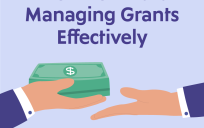For grants professionals, the stakes are even higher during the pandemic given its unprecedented health and economic impacts. While we’re navigating these times, there are insights we can draw from previous economic crises, namely the Great Recession.
 During 2009, I was working in the Governor’s office in Maryland and can empathize with what grants administrators are going through right now. I wanted to share some of the lessons I learned from navigating the American Reinvestment and Recovery Act (ARRA) that we can apply to the CARES Act in the wake of COVID-19.
During 2009, I was working in the Governor’s office in Maryland and can empathize with what grants administrators are going through right now. I wanted to share some of the lessons I learned from navigating the American Reinvestment and Recovery Act (ARRA) that we can apply to the CARES Act in the wake of COVID-19.
As some of you may recall, ARRA was a fiscal stimulus that dedicated $831 billion to providing relief to American families and small businesses impacted by the Great Recession.
There were seven components of the bill:
- Immediate Relief for Families
- Modernize Federal Infrastructure
- Increase Alternative Energy Production
- Expand Health Care
- Improve Education
- Invest in Science Research and Technology
- Help Small Businesses
Similarly, the primary components of the 2020 CARES Act include:
- Individuals ($560 billion)
- Big corporations ($500 billion)
- Small businesses ($377 billion)
- State and local governments ($339.8 billion)
- Public health ($153.5 billion)
- Education/other ($43.7 billion)
- Safety net ($26 billion)
Grants Administration in COVID-19 Era
For those of us who were on the front lines of state grant management during the Great Recession, grant administration itself under the CARES Act will not differ much from navigating ARRA. While the pressures are probably greater this time around, agencies that receive funding must still be prepared to report to the Pandemic Response and Accountability Committee. Under the CARES Act, at least $80 million has been appropriated for this committee and others to establish these reporting tools. For governments, this means multiple appropriations to offices of the Inspector General and that transparency, accountability and compliance are top of mind.
After managing emergency funding in the wake of the Great Recession, I would like to share four best practices with fellow grant administrators to make the most of CARES Act funding while ensuring the utmost transparency during this crisis:
- Establish policy and statutory authority to spend funds. With any reporting-based activity, the first critical step for a grants administrator is ensuring you have the legal authorization to receive CARES Act funds. From a policy perspective, this means getting your legal documents in place. Legal authorization and policies are important for ensuring that new grant programs include the necessary provisions for holding awarding agencies and grantees accountable for funds that are properly used and perform well.
- Focus on naming conventions and tagging. As I’ve mentioned before, having the right naming conventions and tagging certain grants accordingly is essential to staying organized and helping you distinguish which awards can be re-allocated to COVID-19 response. I will defer to my Education Department example. The department recommends that applicants attach a “C” for “COVID” to discern the difference between regular funding received and COVID-19 dollars.
- Maximize the use of your indirect costs. Indirect costs may seem ancillary in grants management, but these are essential to accurately capturing your true costs of service and improved reporting. Governments can use their current indirect cost rates for COVID-19 funding, which takes the stress out of having to negotiate a new one. Additionally, make sure you have your cost allocation plan in place to help you capture those indirect costs. Your cost allocation plan should give you a better picture of what your agency is actually spending; what the cost of a service is; and what it really costs to perform a program or grant. You can learn more about indirect costs and how to use them to maximize COVID-19 funding in this free indirect costs guide.
- Prepare for the Inspector General. All too often, audit findings and compliance issues can be prevented with the right preparation from the beginning. Take time to brush up on the Grant Reporting Efficiency and Agreements Transparency (GREAT) Act of 2019. This legislation provides guidance for decision-makers and awarding agencies while promoting that grantees spend less time on the administrative burden of reporting and more time on service delivery. Performance and reporting is going to be more heavily emphasized, so be sure to proactively engage your Internal Auditor to address any potential issues early on.
Remember, we are in this together. I’m here if you have any questions as we navigate these difficult times. Feel free to share questions in the comments below. You can also read up on this guide on navigating COVID-19 funding.
Next week, I’ll be discussing how digital innovation through automation can help improve your grants management.
As Chief Customer Officer for eCivis, Merril Oliver leads the company’s key business strategies, product development and growth initiatives. Having served four governors, both Democratic and Republican, Merril served as the Director of the Maryland Governor’s Grants Office, where she revolutionized an enterprise approach to full lifecycle grants management during 2015-2017. Merril is a past president of the National Grants Management Association (NGMA), having served three consecutive terms (2009-2012). During her presidency, Merril launched the industry-recognized standard professional certification of Certified Grants Management Specialist (CGMS®) and participated on the credentialing exam development team as a Subject Matter Expert (SME).





Leave a Reply
You must be logged in to post a comment.